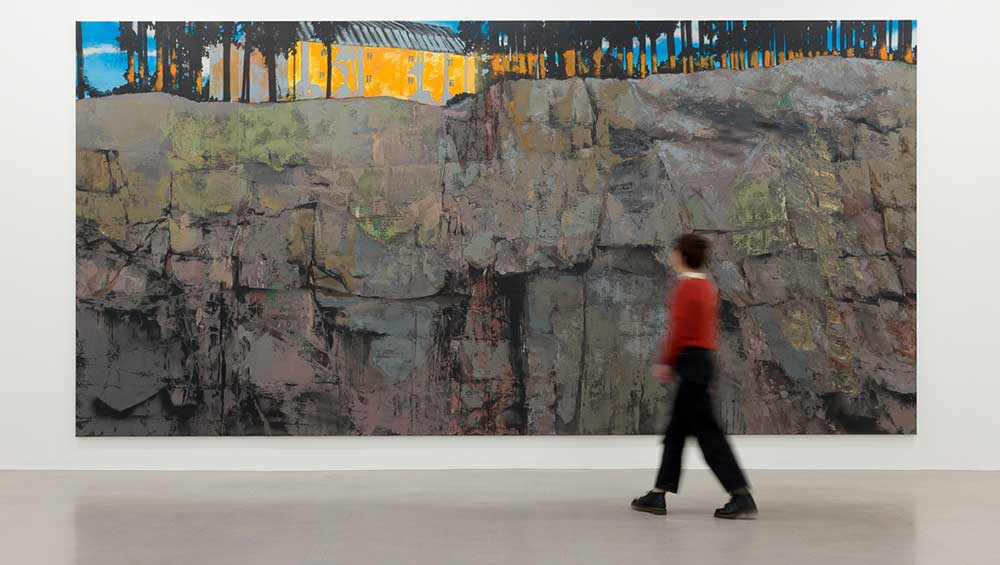
Mohammed Sami. Refugee Camp, 2022. Mixed media on linen, 290 x 590 cm. Installation view, Camden Art Centre, 2023. Photo: Rob Harris.
Camden Art Centre, London
27 January – 28 May 2023
by DAVID TRIGG
When US bombs began raining down on Baghdad in 2003, the Iraqi painter Mohammed Sami (b1984) was at home with his parents and nine siblings, fearing for his life. The “shock and awe” bombardment, which signalled the start of the US-led invasion of his home country, is alluded to in One Thousand and One Nights (2022), a monumental skyscape in the final room of this remarkable exhibition at Camden Art Centre. Recalling the news images of those dreadful first strikes, it is filled with fiery explosions and billowing, smoke-like clouds rendered in a noxious shade of green. Yet Sami is not a war artist and, though he lived through the coalition’s invasion and ensuing sectarian violence, he does not represent those events directly. Rather, his psychologically taut paintings mingle memory and imagination, conjuring disquieting and ambiguous scenes where past traumas collide with present anxieties.
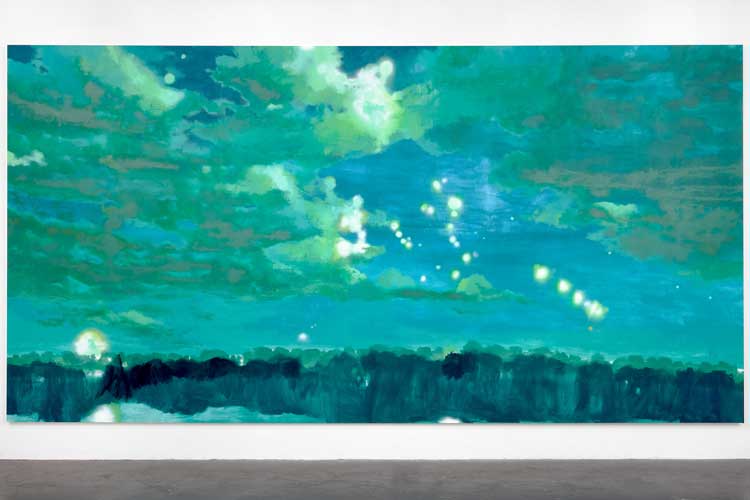
Mohammed Sami. One Thousand and One Nights, 2022. Mixed media on linen, 286 x 557 cm. Courtesy of the artist, Modern Art London and Luhring Augustine New York.
Sami’s artistic talents were spotted early on and, while still at school, he was recruited to paint large-scale propaganda murals for Saddam Hussein’s Ba’ath regime before receiving five years of intensive classical training at the Institute of Fine Arts in Baghdad. After the Iraq war, he fled the country, spending nine months in a Swedish refugee camp in 2007 before studying at Belfast School of Art and earning an MFA at Goldsmiths, University of London in 2018. Now settled in the capital, his distinctive paintings spring from what he calls a “belated response to memory”. But the description of specific memories is not his goal. Instead, his enigmatic images, created without the aid of photographs, are evocations of mood, place and atmosphere, drawing on hazy recollections to describe the essence of past experiences.
.jpg)
Mohammed Sami. Meditation Room, 2022. Mixed media on linen, 280 x 230 cm. Courtesy of the artist, Modern Art London and Luhring Augustine New York.
Sami’s canvases reveal an infatuation with his medium. Acrylic paint is slathered, scraped, smeared and sprayed, sometimes dripping freely, sometimes tightly controlled. Whether describing a domestic interior, landscape, or pile of mattresses, his seductive technique draws you close to his dense surfaces, where images dissolve, becoming almost abstract. Some of his compositions are easy to read, others require more work, such as the brilliant Father Figure I (2019), a complex puzzle of lines and fragmented forms describing a mirror on a tiled bathroom wall. Another composition that rewards slow looking is the unsettling Meditation Room (2022). A door, slightly ajar, lets a narrow beam of light into a dingy interior, its warm glow crosses a crumpled rug and strikes a wall, partially illuminating the image of a military figure. Though the dictator’s face is hidden in shadow, his identity is clear.
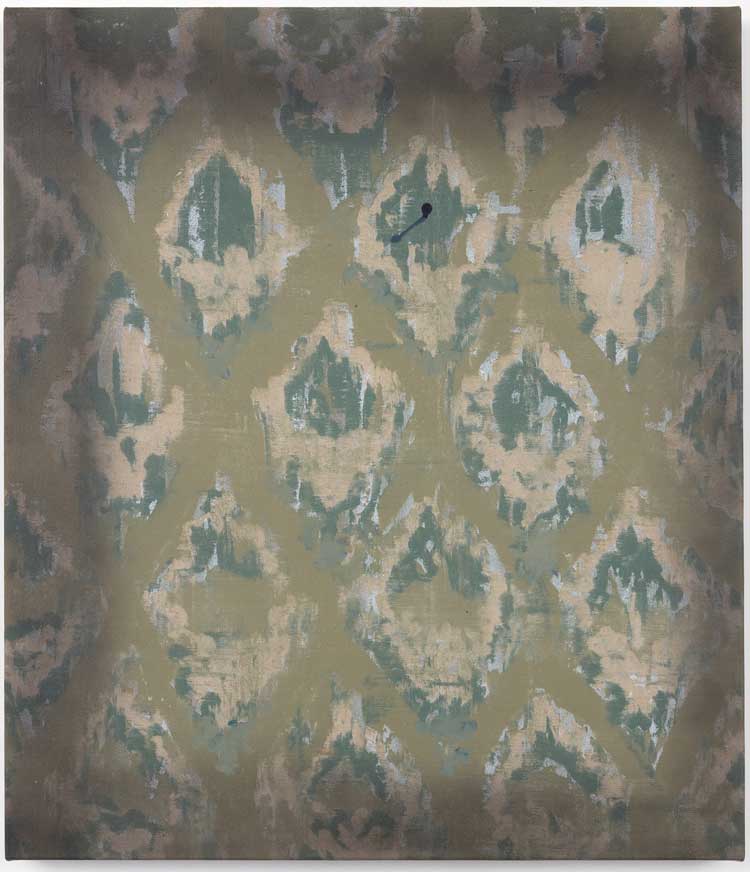
Mohammed Sami. Weeping Walls III, 2022. Mixed media on linen, 75.5 x 65 cm. Courtesy of the artist, Modern Art London and Luhring Augustine New York.
Saddam’s presence haunts many of Sami’s unpeopled works. In Weeping Walls III (2022), a solitary nail casts a thin shadow on to flocked wallpaper; a pale rectangular patch on the greenish brown pattern alludes to, we assume, the obligatory portrait of the dictator that once hung in every Iraqi home. This empty spot could signal hope, but nothing about this claustrophobic image seems optimistic. Similarly, the empty, sepulchre-like lectern in Podium (2022) speaks to absence, while the rows of empty seats in The Parliament Room (2022) can alternatively be read as cemetery headstones – another poignant reminder of the transience of life as well as power. Painted with a lightness of touch, the chairs, like memory itself, become increasingly vague, losing definition as they recede into the gloom.
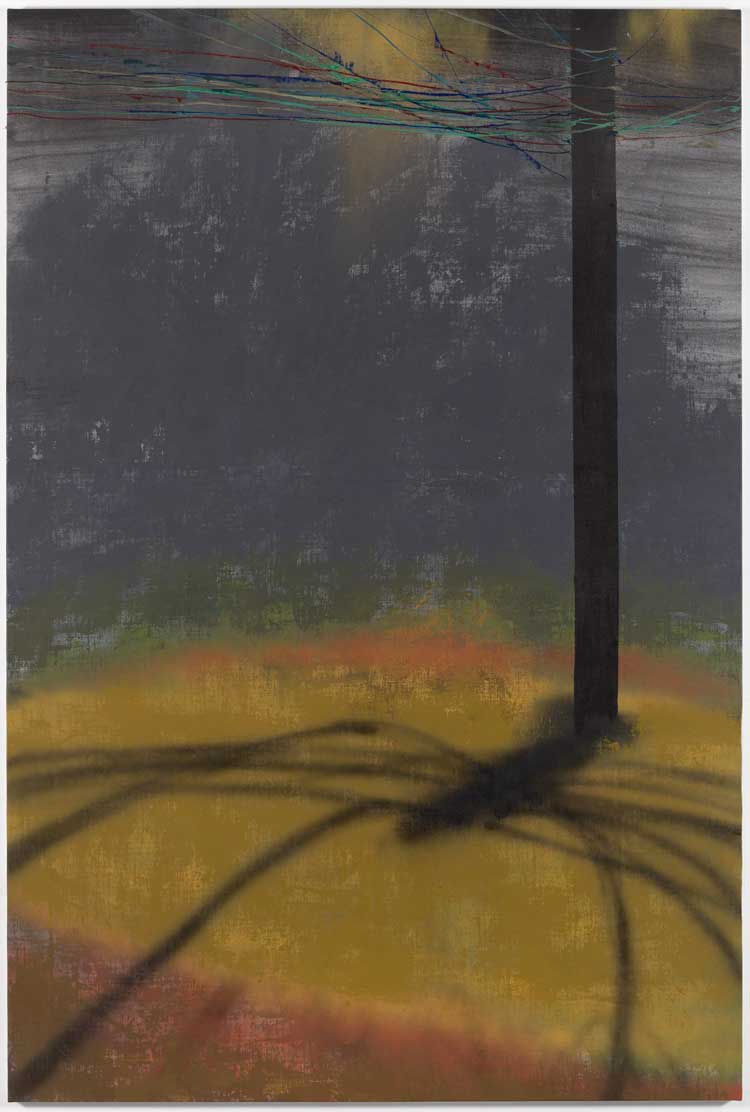
Mohammed Sami. Electric Issues, 2022. Mixed media on linen, 224.5 x 155 cm. Courtesy of the artist, Modern Art London and Luhring Augustine New York.
In Sweden, Sami dabbled with a Dalí-esque surrealism, the influence of which is seen in his fondness for the double image, where elements of a painting can be interpreted in different ways. Take The Praying Room (2021), in which the dark shadow cast by a wilting pot-plant becomes a menacing spider. The conceit is repeated in Electric Issues (2022), where a creepy arachnid on the ground is formed by a tangle of power lines lit by a lamp-post. Nearby, Jellyfish (2022) demands another double take. That this painting depicts a gelatinous sea creature initially seems plausible, but look again and you see the aftermath of a missile strike: a mass of cables and debris hanging through a gaping hole in a roof.
.jpg)
Mohammed Sami. Jellyfish, 2022. Mixed media on linen, 145 x 230 cm. Courtesy of the artist, Modern Art London and Luhring Augustine New York.
The largest work here, Refugee Camp (2022), is nearly six metres wide. At the top of the composition a large building surrounded by trees sits high up on a cliff, its walls lit by a burning orange sun. The rest of the painting is an imposing wall of rock: a mass of greys, browns and mauves that consumes your field of vision. Like a Gerhard Richter abstract, the heavily worked surface is a world in itself. It feels insurmountable. Sami has made several paintings of this Swedish camp and all of them feel dark and foreboding. Yet he talks about his time there in positive terms, as “the most beautiful days in my life”. It was here that he experienced emancipation, and this canvas – indeed the entire show – is an acknowledgement of that freedom.
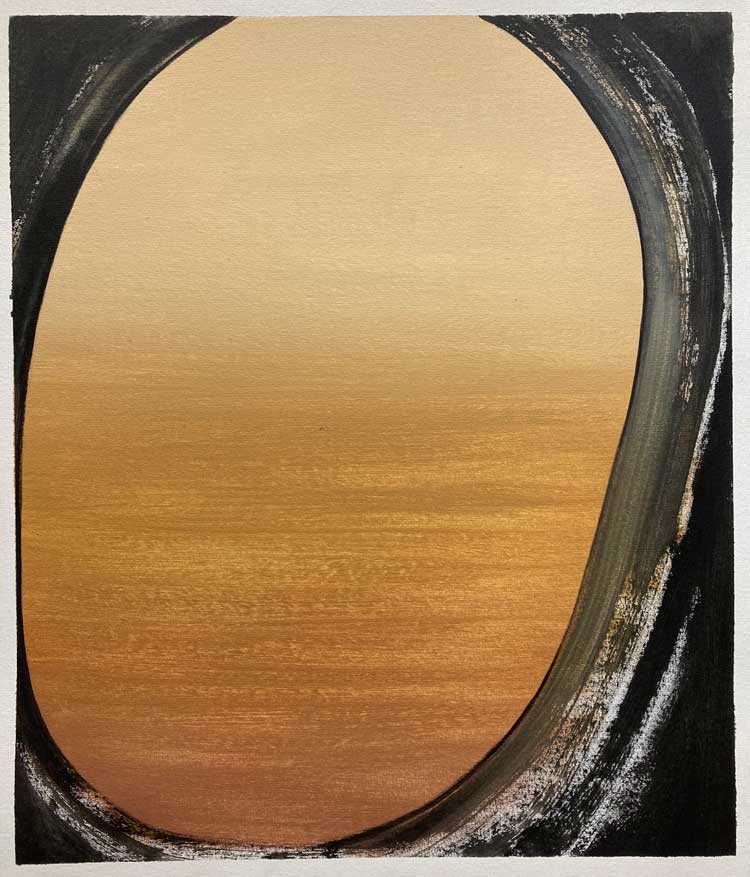
Mohammed Sami. The Point 0, 2020. Acrylic on linen, 170 x 120 cm. Courtesy of the artist, Modern Art London and Luhring Augustine New York.
For Sami, the refugee camp was his “point zero”, the place, he says, where he was “born again”. It was where he stopped fearing for his life, where there were suddenly no restrictions on who he could talk to or be seen with. His small painting, The Point 0 (2020), which lends its title to this exhibition, depicts an aeroplane window, its oval frame suggesting a zero and the view outside an empty, dusty expanse. Inspired by a recent visit to Baghdad, it speaks to the frailty of memory but also the potential for starting afresh. Sami has received a new beginning, though as his extraordinary paintings attest, the past casts a long shadow.